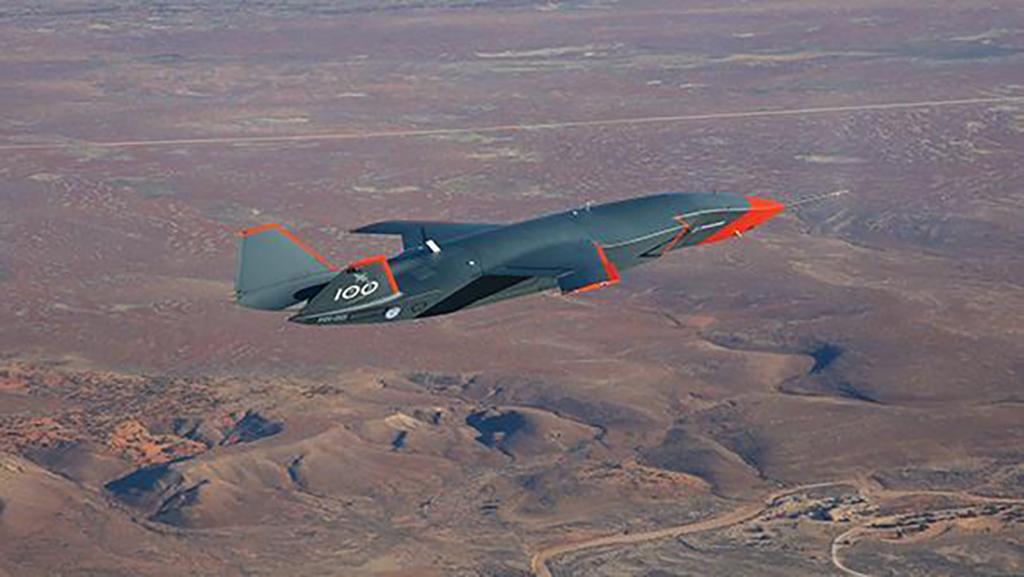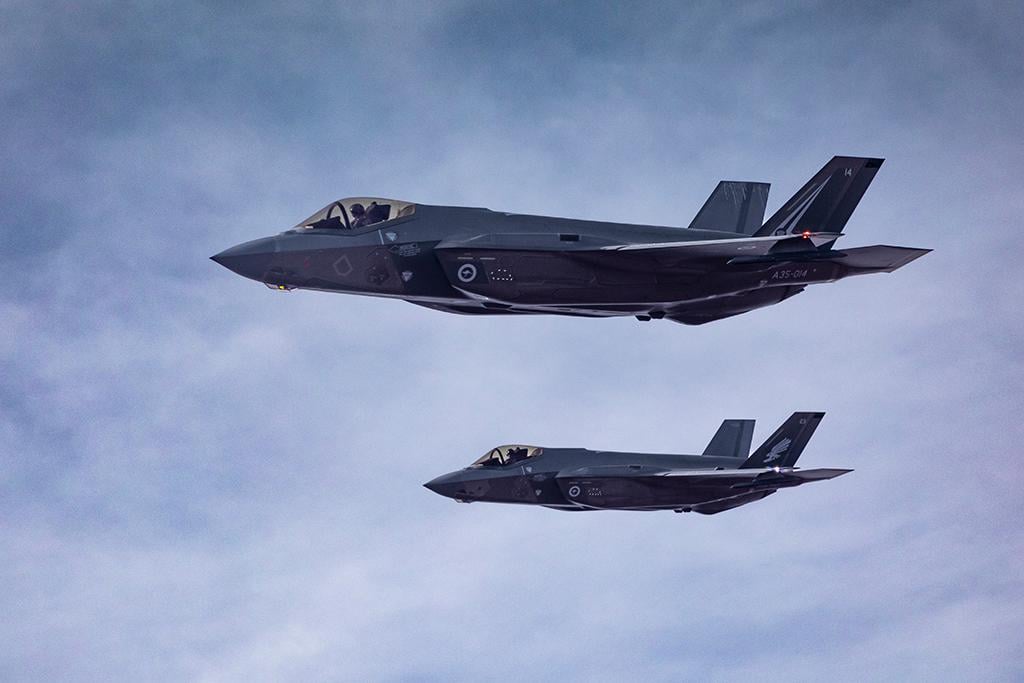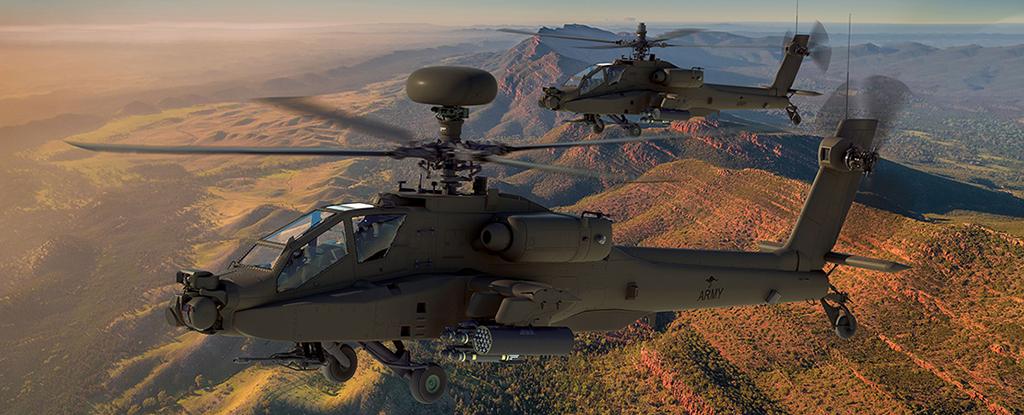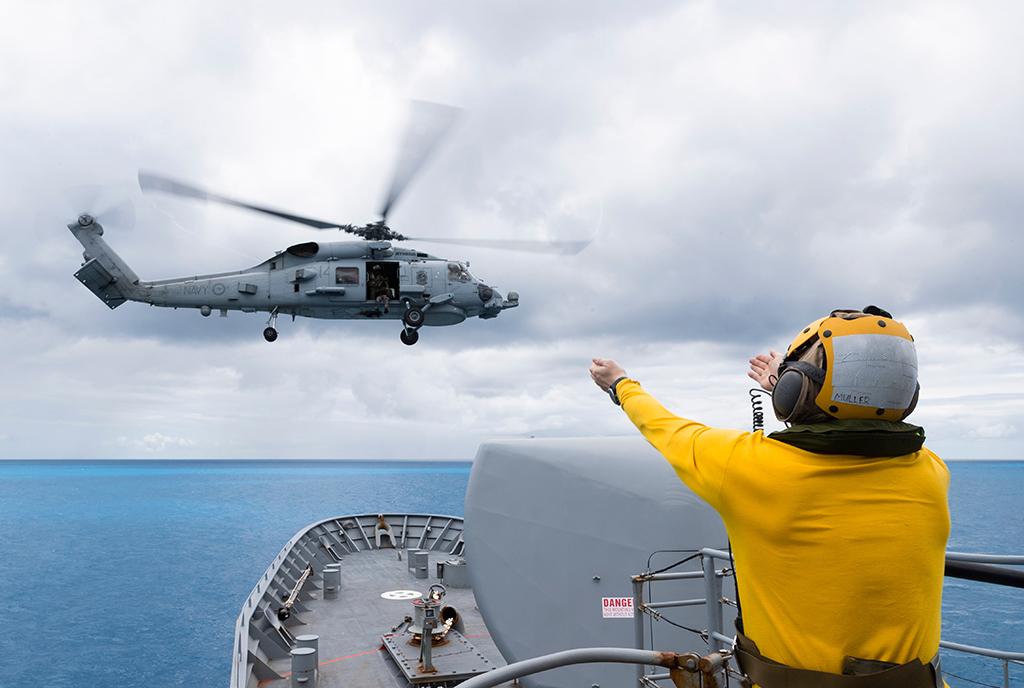Gallery: U.S. Industry Contributions To Australia’s Fleets
Steve Trimble Jen DiMascio February 02, 2023
MQ-28A Ghost Bat
Boeing’s Australian division is expected to finish designing and start manufacturing the second-generation version of the fighter-like, uncrewed aircraft system (UAS) this year. The first three prototypes have been in flight testing since the first model achieved its initial flight on Feb. 7, 2021. Another seven of the low-cost, “Loyal Wingman” UAS will be acquired by the Royal Australian Air Force (RAAF), raising the overall fleet to 10. All of the composite aircraft are being produced on an automated Boeing assembly line in Brisbane. The total budget for development and manufacturing is A$672 million ($475 million).

F-35A Lightning II
No. 75 Sqdn. started transitioning to the Lockheed Martin stealth fighter last year, becoming the last of three RAAF operational and one conversion unit to fly F-35As. A full operational capability milestone is on track to be achieved in December, with all 72 Lightning IIs delivered since 2014. The activation of No. 75 Sqdn. also will establish an F-35 presence in the Northern Territory at RAAF Base Tindal, with the other Lightning II units remaining at RAAF Base Williamtown in New South Wales. The Australian Defense Department’s focus is shifting to improving the country’s ability to support F-35s in the region, with reprogramming, weapons warehousing and depot repair capacity expanding.

MC-55 Peregrine
Ground support systems were due to be installed at RAAF Base Edinburgh in late 2022, but the timing of the first arrival of four new Gulfstream G550 special mission aircraft has never been revealed. The U.S. Air Force’s secretive Big Safari cell is continuing to modify the four MC-55s acquired by the RAAF in Greenville, Texas, but the mission systems onboard also remain a closely held secret. The MC-55 is configured with a canoe fairing under the forward fuselage, a satellite communications farm on top of the fuselage and a bulbous antenna housing atop the vertical stabilizer. The RAAF has operated an electronic warfare variant of the AP-3C, but the MC-55 is billed as a new capability for long-range intelligence, surveillance and reconnaissance.

P-8A Poseidon
The last two of 14 maritime patrol aircraft derived from the Boeing 737 are due for delivery imminently. The latter order reflects an Australian government decision in late 2020 to top off a previous order of 12 P-8As, with the full dozen delivered to RAAF Base Edinburgh by 2019. The RAAF plans to equip the P-8A fleet with the AGM-158C Long-Range Anti-Ship Missile, and it named the patrol aircraft as a candidate platform to air-launch the scramjet-powered Hypersonic Attack Cruise Missile still in development.

MQ-4C Triton
The fate of the procurement of the RAAF’s first high-altitude uncrewed aircraft system hinges on the outcome of the Defense Security Review. The first of three MQ-4C Tritons on order by Australia was unveiled last September in Palmdale, California, with a scheduled aircraft delivery to RAAF Base Tindal in mid-2024. By mid-2026, the RAAF expects to be able to operate a single, continuous patrol capability north of Australia with the three aircraft. A second orbit of three aircraft, plus a spare, also could be acquired, pending the outcome of the review.

C-130J Hercules
Australia’s latest fleet decision is to buy up to 24 Lockheed Martin C-130J-30 airlifters, replacing and doubling a fleet of 12 Hercules acquired in 1999. The announcement in November did not provide a timeline for aircraft delivery, but the selection under Project Air 7404 Phase 1 will be forwarded for government approval this year.

AH-64E Apache
Boeing’s attack helicopter is slated to arrive in Australia in 2025. The Australian Army’s selection of the AH-64E in 2021 came as a surprise. The Defense Department had released no tender to replace a fleet of 25 Eurocopter Tigers, which were demonstrating improving availability after a disappointing start. But the Tigers are planned be replaced by 29 Apaches starting in the third quarter of 2023, completing a nearly complete pivot by Australia from European to U.S. military aircraft.

UH-60 Black Hawk
NHIndustries’ loss is Sikorsky’s gain. In December 2021, the Australian Army gave up on attempts to improve the maintenance and reduce the cost of operating the MRH90. The Morrison government instead opened discussions with the U.S. government to buy up to 40 UH-60M Black Hawk utility helicopters. The Royal Australian Navy already operates the MH-60R Seahawk, with a second batch of 12 awarded last May.
Australia continues to expand purchases of equipment made by U.S. companies. That includes the Boeing Australia development of the MQ-28 Ghost Bat as well as recent discussions to buy Sikorsky UH-60 Black Hawk helicopters. Here is a look at the platforms of interest across the Australian armed forces.
Read more about Australia’s post-AUKUS defense push that is expected to be showcased at this year’s Avalon Airshow.

